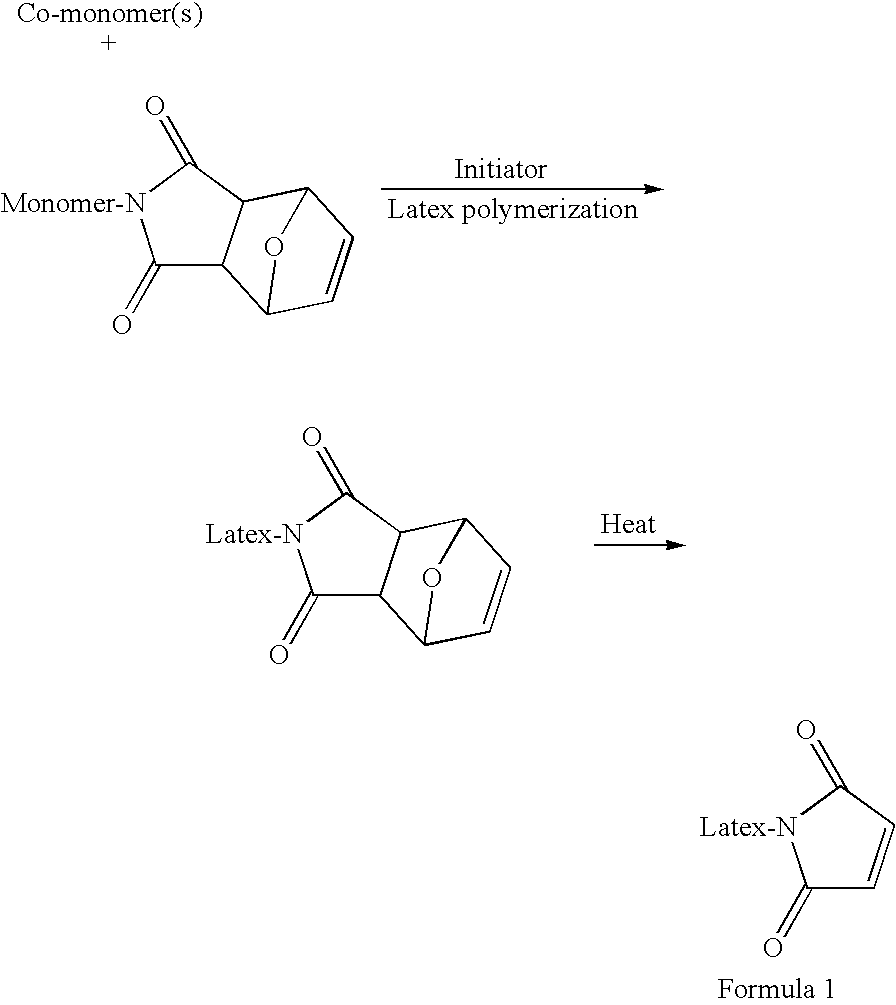Maleimide-containing latex dispersions
a technology of latex and maleimide, which is applied in the field of maleimide-containing latex dispersions, can solve the problems of poor durability of ink-jet prints, and achieve the effect of improving durability and reducing the number of ink-jet prints
- Summary
- Abstract
- Description
- Claims
- Application Information
AI Technical Summary
Benefits of technology
Problems solved by technology
Method used
Image
Examples
example 1
Preparation of Blocked Maleimide Monomer
[0043]The preparation of the blocked maleimide monomer is followed generally in accordance with Formula 2 above. Specifically, a mixture of maleimide (1) (19.4 g, 0.2 mol), furan (2) (13.6 g, 0.2 mol), and aluminium chloride (33.25 g, 0.25 mol) in 200 ml of dichloromethane is refluxed under nitrogen atmosphere for 24 hours. After cooling down to room temperature, the mixture is poured onto 250 g of ice-water. The pH value of the mixture is neutralized to around pH 7, then the organic layer is separated. The aqueous layer is further extracted with dicholormethane (2×50 mL). The combined organic layer is washed with saturated sodium bicarbonate, water, and brine, dried over sodium sulfate. Evaporation of solvent and further purification by flash chromatography is carried out, giving exo-3,6-epoxy-1,2,3,6-tetrahydrophthalic anhydride (3) (28 g, 85%) of the product as a white solid.
[0044]To a solution of exo-3,6-epoxy-1,2,3,6-tetrahydrophthalic an...
example 2
Preparation of Latex Incorporating Maleimide Surface Groups
[0046]Monomer (9) (10 g) of Formula 2 is mixed with methyl methacrylate (90 g) to form a monomer mixture. This monomer mixture is emulsified with Rhodafac RS 710 surfactant (2.5 g; 2.5 wt % with respect to the monomers) in water (40 ml). The monomer emulsion is added drop-wise to water (360 ml) at 60° C. containing a potassium persulfate water soluble initiator (about 0.4 wt % with respect to the monomers). The heating is continued at this temperature for a period of two hours and then cooled to ambient temperature. The particulates formed are present in a latex dispersion or emulsion. In this example, the blocked maleimide groups are present in the latex throughout the particle. The same reaction can be carried out to present the blocked maleimide groups mostly on the surface by adding the above blocked monomer after other monomer(s) of the mixture is / are added. Though a cross-linker is not used in this example, it is to be...
example 3
Preparation of Latex Incorporating Maleimide Surface Groups
[0047]In the Example 2, the monomer (9) is replaced to monomer (7) of Formula 2 and the process is carried out under identical conditions to obtain the latex with at least surface maleimide groups.
PUM
| Property | Measurement | Unit |
|---|---|---|
| wt % | aaaaa | aaaaa |
| particle size | aaaaa | aaaaa |
| wt % | aaaaa | aaaaa |
Abstract
Description
Claims
Application Information
 Login to View More
Login to View More - R&D
- Intellectual Property
- Life Sciences
- Materials
- Tech Scout
- Unparalleled Data Quality
- Higher Quality Content
- 60% Fewer Hallucinations
Browse by: Latest US Patents, China's latest patents, Technical Efficacy Thesaurus, Application Domain, Technology Topic, Popular Technical Reports.
© 2025 PatSnap. All rights reserved.Legal|Privacy policy|Modern Slavery Act Transparency Statement|Sitemap|About US| Contact US: help@patsnap.com



